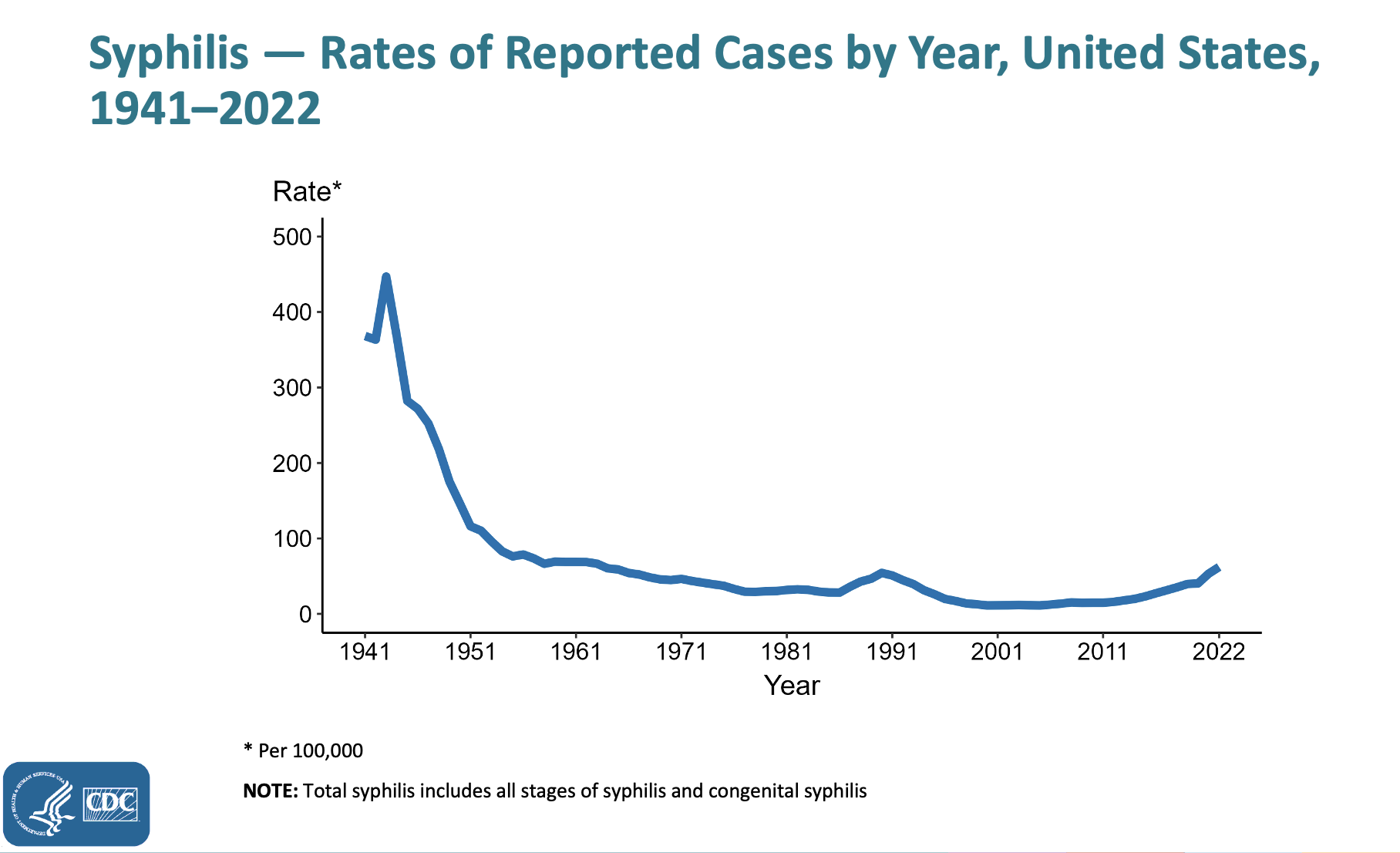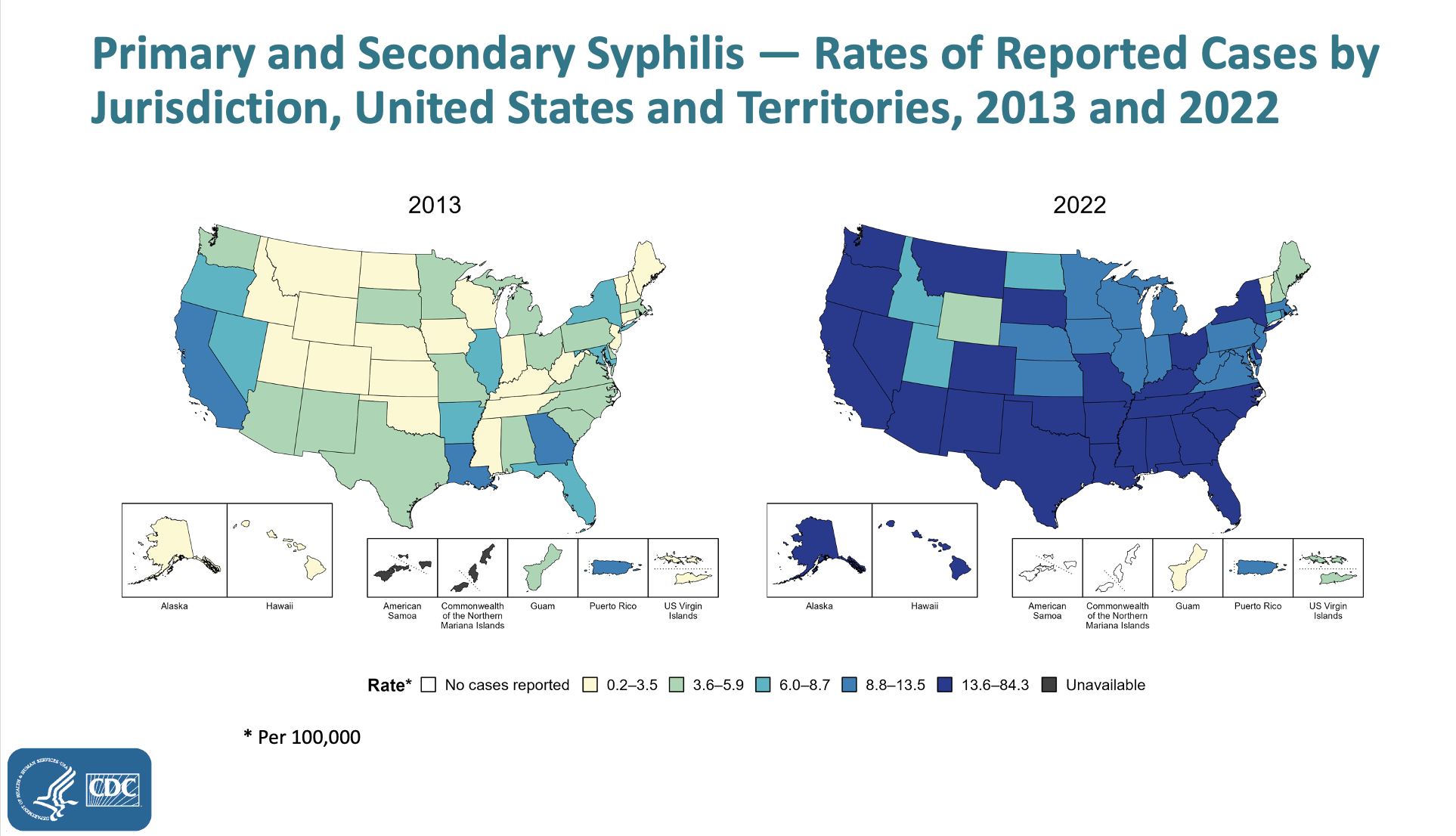Syphilis, a sexually transmitted infection once under control from spreading in the U.S., is now reaching case levels not seen in more than 70 years, according to a new federal government report.
More than 207,000 syphilis cases were reported in 2022, the most recent year of data. That marks a nearly 80% jump in diagnoses since 2018 and a 17% increase from the year prior, the Centers for Disease Control and Prevention's data shows.

It's also the highest number of syphilis cases the U.S. has seen since 1950, when the use of penicillin to treat the rapidly spreading disease began expanding and led to a steep decline in infection rates.
But despite treatments helping rates hit historic lows in 2000 and 2001, primary and secondary (P&S) syphilis cases — the most infectious stages — have now risen every year since, spiking 9.3% from 2021 to 2022, the CDC says.
Who is most affected, and where?
Although the spread isn't avoiding any certain group, it's particularly hitting certain sexes, age groups and ethnic groups harder in recent years.
For example, the newest data shows syphilis continues to disproportionately affect gay and bisexual men, but it also highlights an increasing spread to heterosexual men and women, with P&S cases in women jumping more than 19% and making up a quarter of all infectious cases in 2022.
This is also concerning as rates of congenital syphilis, passed by an infected woman to a fetus during pregnancy, have continued to climb in recent years, as have the rate of P&S syphilis cases in reproductive-aged women.
In 2022, the national congenital syphilis rate in live births marked a 30.6% increase from the year before and a 183.4% increase since 2018. This led to 282 stillbirths and infant deaths.
The report also showed infectious syphilis cases rose most in racial/Hispanic ethnicity groups, with the largest increases among non-Hispanic American Indian/Alaska Native persons. This coincides with South Dakota having the highest case-per-population rate among U.S. states in 2022 — more than twice the second-highest in New Mexico — driven by an outbreak in the state's Native American community, who have limited access to STI testing and treatment, per The Associated Press.

Why is syphilis spreading more rapidly, and how will it be stopped?
Syphilis is a bacterial infection typically marked by painful sores, though each of the four stages — primary, secondary, latent and tertiary — can have different signs and symptoms.
Without treatment during the first and second stages, the infection can be in a person's body for years with no signs or symptoms, and left untreated, it can lead to organ damage or failure and even death.
In recent years, the antibiotics used to treat these infections have seen shortages, all while there have been fewer funded health clinics and professionals to assist patients seeking help.
Experts also point to increases in substance abuse leading to risky sexual behavior, decrease in condom usage and the COVID-19 pandemic — which disrupted reporting and reduction efforts — as reasons for the spike in cases.
Lawmakers and health care professionals are now working to reduce the stigma surrounding STIs to improve timely diagnoses and treatment, as the Biden administration has taken several federal steps to curb the epidemic.
Last year, the White House launched a federal syphilis task force to focus on reducing rates where they're currently highest.
And earlier this month, the U.S. Food and Drug Administration announced the availability of Extencilline to aid in the shortage of Bicillin L-A, typically used to treat syphilis — particularly in pregnant moms.
What about the rates of other STIs?
The report wasn't all about syphilis, and it wasn't all about increasing rates.
Gonorrhea, which has been steadily rising since 2009, saw a nearly 9% decrease in cases from 2021 to 2022. Experts say it's unclear why this occurred.
And chlamydia, by far the most prevalent STI, saw a relatively flat rate of cases from 2021 to 2022 but marked a 6.2% decline in the five years prior. The CDC, however, says this may be due to a higher amount of undiagnosed infections as a result of reduced screenings during the pandemic and as health departments prioritized syphilis and gonorrhea testing.
Trending stories at Scrippsnews.com


